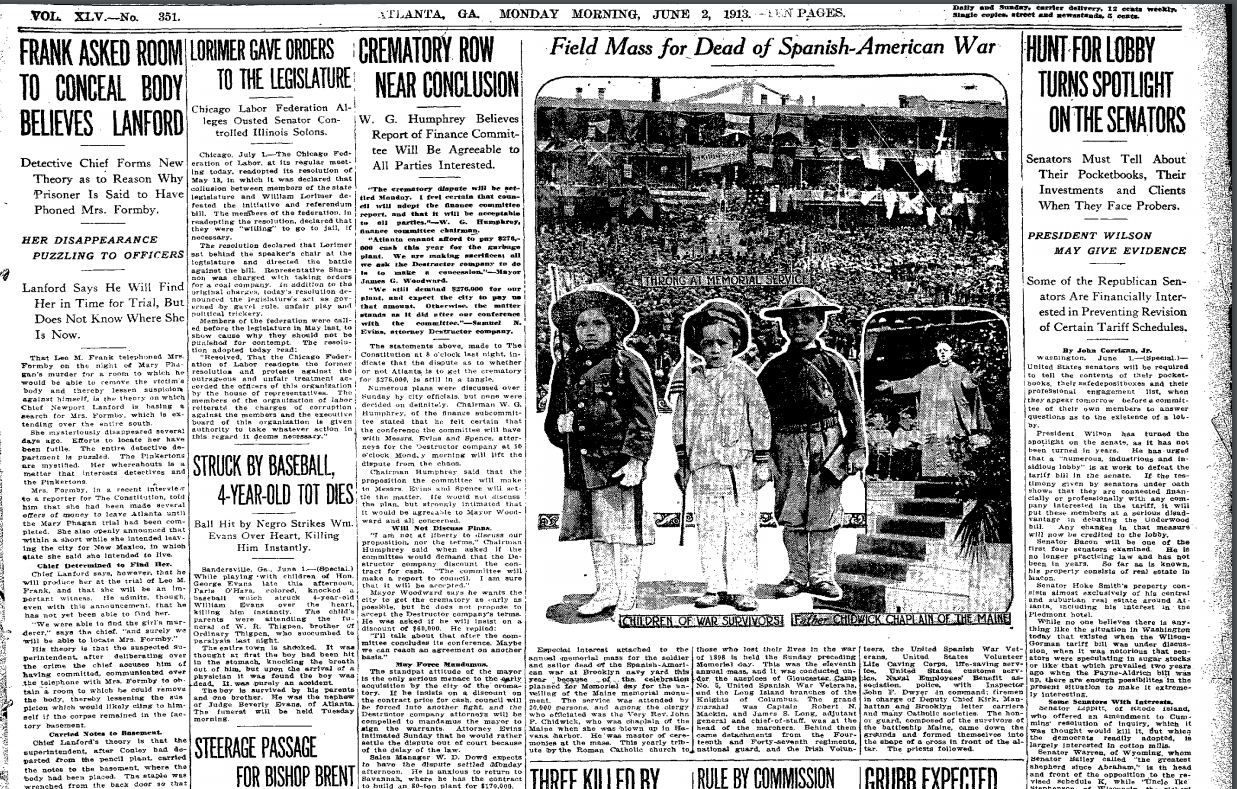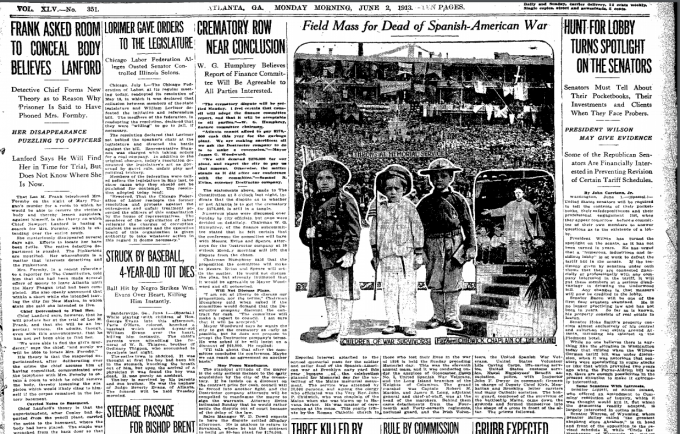Another in our series of new transcriptions of contemporary articles on the Leo Frank case.
Atlanta Constitution
Monday, June 2nd, 1913
Detective Chief Forms New Theory as to Reason Why Prisoner Is Said to Have Phoned Mrs. Formby.
HER DISAPPEARANCE PUZZLING TO OFFICERS
Lanford Says He Will Find Her in Time for Trial, But Does Not Know Where She Is Now.
That Leo M. Frank telephoned Mrs. Formby on the night of Mary Phagan’s murder for a room to which he would be able to remove the victim’s body and thereby lessen suspicion against himself, is the theory on which Chief Newport Lanford is basing a search for Mrs. Formby, which is extending over the entire south.
She mysteriously disappeared several days ago. Efforts to locate her have been futile. The entire detective department is puzzled. The Pinkertons are mystified. Her whereabouts is a matter that interests detectives and the Pinkertons.
Mrs. Formby, in a recent interview to a reporter for The Constitution, told him that she had been made several offers of money to leave Atlanta until the Mary Phagan trial had been completed. She also openly announced that within a short while she intended leaving the city for New Mexico, in which state she said she intended to live.
Chief Determined to Find Her.
Chief Lanford says, however, that he will produce her at the trial of Leo M. Frank, and that she will be an important witness. He admits, though, even with this announcement, that he has not yet been able to find her.
“We were able to find the girl’s murderer,” says the chief, “and surely we will be able to locate Mrs. Formby.”
His theory is that the suspected superintendent, after deliberating over the crime the chief accuses him of having committed, communicated over the telephone with Mrs. Formby to obtain a room to which he could remove the body, thereby lessening the suspicion which would likely cling to himself if the corpse remained in the factory basement.
Carried Notes to Basement.
Chief Lanford’s theory is that the superintendent, after Conley had departed from the pencil plant, carried the notes to the basement, where the body had been placed. The staple was wrenched from the back door so that in case a cab or other conveyance which might drive up the runway in rear of the building could back up to the door to receive the ghastly freight.
He believes that Frank, when he discovered he could not obtain a room at Mrs. Formby’s, the only woman he could trust, dared not communicate with any other place, so he went to his home, leaving the body in the basement.
That is the chief’s theory as outlined to a reporter for The Constitution Sunday afternoon. It will be remembered that Conley, in his confession to having helped the superintendent remove the body to cellar, declared he did not see Frank take the notes from his desk in the office on the second floor, and that he knew nothing of the staple being extracted from the rear door.
Mrs. Formby several days ago stated to a Constitution reporter that Frank had told her over the telephone that night that it was a matter of life or death, and that if she did not rent him a room in her place, she was liable to be killed.
Corroboration of Mrs. Formby’s story of the telephone messages is hinted by Lanford, who told the reporter Sunday afternoon that the telephone operators who testified before the grand jury on the Friday of its session were “believed” to have told of overhearing Frank’s communication with the Formby woman.
Lanford Attacks Mangum.
Chief Lanford, in a talk with The Constitution Sunday afternoon, raps Sheriff C. Wheeler Mangum for his attitude in preventing the detectives from confronting Frank with the negro Conley, and his remarkable admission. The detective declares that Mangum is playing politics, and in an effort to remain in the office of sheriff is catering to friends of his prisoner by refusing to admit the sleuths to the suspect’s cell.
Will Not Reveal Names.
He will not reveal the names of the operators, and will not state positively the nature of their evidence, except that the tell of certain telephonic communication alleged to have been held by the suspected pencil factory official during the night of the Mary Phagan tragedy.
James Conley, the negro sweeper, apparently feels safer in the police headquarter’s prison than he did in the Tower. Chief Lanford says that it was at the negro’s request that he was removed to the station house. Attempts were made, the chief declares, to intimidate the imprisoned sweeper.
“This itself,” says the chief, “is evidence of Sheriff Mangum’s partiality. He should have allowed no one to see the negro, inasmuch as he kept everyone from Frank except his friends. Conley never asked to see any of those folks who came to his cell and threatened him. It’s outrageous, that’s all I can say about it. A new regime is needed. Politics and the sheriff’s administration can’t go hand in hand.”
Conley has made no new confession. Lanford and his men say they do not expect anything more from him than the story that has already been told. Solicitor Dorsey even is said to have expressed the same opinion. That the sweeper is telling the unadulterated truth is the opinion of headquarters detectives and Superintendent Harry Scott of the Pinkertons.
* * *
Atlanta Constitution, June 2nd 1913, “Frank Asked Room to Conceal Body Believes Lanford,” Leo Frank case newspaper article series (Original PDF)

